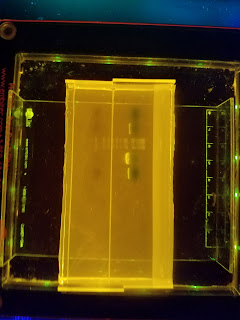Week 4
I got right back to work this week after my mentor arrived from Minneapolis on Monday. The final DNA sequences had finally arrived while we were out, so we began the process of molecular cloning: inserting the sequences into plasmids (larger, circular DNA fragments that carry the desired sequences), coaxing some bacteria into taking in and naturally reproducing the plasmids, and finally purifying the "cloned" DNA product.
This can be done in a variety of ways, but many traditional methods involve expensive kits or have an unacceptable risk of mutation. So we used FastCloning, an inexpensive and effective method that my mentor developed and published in 2011.
It carries that name because it is faster than the aforementioned methods; however, as I was about to discover, it is still very time-consuming (at least with my lack of experience). This one's a bit of a doozy; consider it as a supplement to last week's incredibly short one.
--------------------------------------------------------------------------------------------------------------------------
On Tuesday, I began by amplifying (making more of) the DNA we had received, as manufacturers ship a very small amount to laboratories, knowing that they are equipped to make more. To do this, I prepared a solution that contains the elementary building blocks of DNA as well as an heat-resistant enzyme that replicates DNA. I then added in the DNA we had received and used a technique known as PCR.
Short for "Polymerase Chain Reaction," it consists of repeatedly heating that solution to unravel the DNA and allow the enzyme to replicate it then cooling it to bring the DNA back together. This process happens several times (17, to be exact) and doubles the amount of DNA with each cycle, generating a large amount very quickly.
This can be done in a variety of ways, but many traditional methods involve expensive kits or have an unacceptable risk of mutation. So we used FastCloning, an inexpensive and effective method that my mentor developed and published in 2011.
It carries that name because it is faster than the aforementioned methods; however, as I was about to discover, it is still very time-consuming (at least with my lack of experience). This one's a bit of a doozy; consider it as a supplement to last week's incredibly short one.
--------------------------------------------------------------------------------------------------------------------------
On Tuesday, I began by amplifying (making more of) the DNA we had received, as manufacturers ship a very small amount to laboratories, knowing that they are equipped to make more. To do this, I prepared a solution that contains the elementary building blocks of DNA as well as an heat-resistant enzyme that replicates DNA. I then added in the DNA we had received and used a technique known as PCR.
Short for "Polymerase Chain Reaction," it consists of repeatedly heating that solution to unravel the DNA and allow the enzyme to replicate it then cooling it to bring the DNA back together. This process happens several times (17, to be exact) and doubles the amount of DNA with each cycle, generating a large amount very quickly.
The PCR machine. Underneath its innocuous cover, science is transpiring.
The PCR finished that day, so the next step was to confirm we even had any product via gel electrophoresis, which uses an electric current to move DNA through a gel at varying speeds depending on the size of the DNA fragments. The results were definitely wrong the first time I tried it, as nothing showed up, not even the control DNA.
On Wednesday, I tried running the gel again with a new agarose solution and found success; the previous solution was most likely expired.
The gel before migration. The blue wells contain DNA, mixed with a special fluorescent dye.
After migration. The DNA has clearly moved - now to apply a blue light/filter (the one that dentists use for fillings)
The DNA fragments clearly fluoresce, and their positions all indicate successful PCR.
Now that the plasmids had been replicated, I simply combined them with the desired sequences for insertions and an enzyme that would "digest" them and allow them to coalesce.
Finally, I mixed the newly recombined plasmids with some E. coli and spread them out on some Petri dishes to form colonies.
After they had been shaken the entire night, I returned Thursday morning to find . . . that they still needed more time to grow. So I instead prepared a massive quantity of the incubation solution for the frog eggs that we'll be using soon.
That afternoon, I cultured the bacteria (like in my second week) and put them in a shaker overnight.
On Friday, I went through the centrifugation procedure that Dr. Chang had also performed in the second week, to get rid of the bacteria and isolate the DNA that they had so kindly replicated for us. It's currently sitting in a freezer-- we're getting closer to injecting the frog oocytes every day!
I thank you (and applaud you) for making it through this wall of text. I got to use some really cool technology this week, hence my digressions (which I trimmed severely).
Until next week!






FastCloning sounds very cool! Can't wait to see your results and how you master efficient technology.
ReplyDeleteThis cloning is really interesting! It kind of makes you wish we could do some of these experiments in the Brain and Behavior class.
ReplyDelete